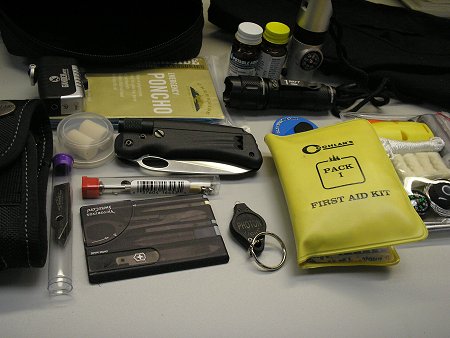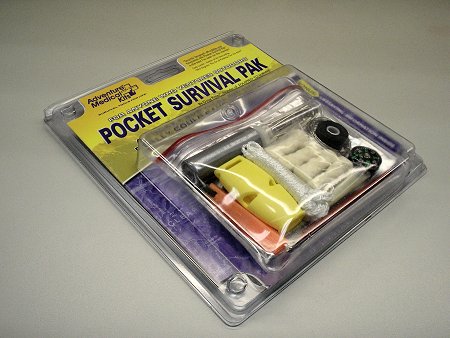its paid sponsors, whose products you need!
“Stay ‘unreasonable.’ If you
don’t like the solutions [available to you], come up with your
own.”
Dan Webre
The Martialist does
not
constitute legal advice. It is for ENTERTAINMENT
PURPOSES ONLY.
Copyright © 2003-2004 Phil Elmore, all rights
reserved.
Minimum Accessories for Personal
Preparedness (Revised 2006)
By Phil Elmore
Human beings
are tool-using creatures.
As a species we have created a mind-numbing array of useful (and
sometimes not-so-useful) tools, conveniences, gadgets, widgets, and
novelties that can make daily life easier. No tool is useful if you do
not have it, however. For every emergency, there is a tool or accessory
that can assist you in overcoming adversity — but you must have the
tools you need when you need them.

Contents of the author’s on-body preparedness kit
include all the essentials.
As the old saying goes, “You can’t
make an
appointment for an emergency.” You can, however, make sure that you are
equipped on a day-to-day basis with useful tools and accessories. You
can’t anticipate every problem, but you can take the sting out of many
of them. The minimum you should carry to be prepared for life’s
emergencies includes funds, a means of communication, and the basics of
utility, self-defense, and self-preparation.
While most of your minimum
accessories can be carried
on your person and in your pockets, I recommend that you take the time
to create a small, mobile, on-body kit so you have the bare minimum
necessary to live as a prepared martialist. The specific categories and
items I recommend you cover are these:
-
Cash
-
Communications (a wireless phone) or
CB radio -
Light (a flashlight)
-
Fire (a lighter)
-
Water (potable aqua)
-
Tools (a multitool, ideally, or at
least a knife) -
First Aid
-
Bandanna
-
Shelter (disposable pancho and/or
emergency blanket) -
Direction (a compass)
FUNDS
I’m going to assume that you
already understand the
single most important thing you need to have with you on a daily basis:
money. Cash is most important of all, but you should also have credit
or debit cards (typically these will be carried in your wallet — I
never go anywhere without mine) on which to fall back in case of more
extreme need. Nothing will hamstring you more than simply lacking funds
in modern living. Make sure you carry enough money. I carry a backup
stack of twenties in my on-body survival kit.
COMMUNICATION
No matter who and where you are,
you should be
carrying a wireless phone. Phones are so inexpensive and easy to get
these days, thanks to the numerous prepaid plans on the market, that
the people who make wireless phones are practically driving around on
the backs of Mardi Gras floats hurling handfuls of these things into
crowds. A lifeline to medical care, towing for your car, concerned
family members, or to your employer when you’re stuck in in traffic,
the wireless phone is a way for you to reach whomever you must in an
emergency — and for those about whom you care to reach you when they
need you. Sure, your phone is probably giving you a brain tumor — but
that’s years away, while your car is right here and right now while
it’s sitting in a ten-foot ditch after sliding off an icy highway.
Wireless phones are vulnerable to signal
coverage
problems and dead batteries, of course, which is why you might choose
to carry a prepaid phone card (something Morgan Atwood also recommends
for the urban encounter survival kit). That way you can use a land
line, either in a place of business or through a pay phone, with a
minimum of hassle.
LIGHT
You should get into the habit of
carrying a
flashlight all the time, even during the day. Flashlights are very
useful utility tools even at the best of times. I’ve used mine for
everything from checking cables behind the computer to crossing busy
streets at night. If the power goes out and you’re indoors away from
windows, you’ll be glad you had a light. You just never know when you
might need a light source — and today’s tiny LED torches make it
possible to carry a useful light all the time without effort.
FIRE
The ability to make fire when you
need it is one of
those things that separates us from the earliest proto-humans. Fire is
infinitely useful. It creates light, it creates heat, it can be used to
boil water and cleanse implements, it can cook food, it can harden
wood, it can seal ballistic nylon and paracord… the list goes on. You
cannot afford to overlook this. In a minimial on-body kit, a simple
disposable lighter will do. The lighter in my kit is a Gander Mountain
high-temperature model, which is resistant to wind and refillable with
commonly available butane.
WATER
Some survivalists and martialists
carry bottled water
or water rations with them. I don’t do this because of the weight such
supplies add to the kit. You can carry a small bottle of potable aqua
tablets without difficulty, however. Carry the neutralizer tablets too,
if you don’t want to drink something that tastes like utter crap. (Even
then, don’t get your hopes up.) In my daily carry bag I carry a filter
straw, which accomplishes the same function but doesn’t require mixing
anything.
TOOLS
In a market flooded with high-tech
multitools, you
have no excuse not to include one in your daily kit. Most multitools
include a knife, a couple of drivers, and some pliers, which ought to
get you through most moderate emergencies.
FIRST AID
I can’t count the number of times
I’ve needed a
simple band-aid when I was away from home (or away from the emergency
first aid kit I keep attached to my desk at work). Even if your “first
aid kit” consists of a handful of band-aids, it’s better to have those
than nothing. If you can include an entire small first aid kit, so much
the better.
BANDANNA
A bandanna is
one
the most useful multi-purpose items you can carry on your person. I
keep one folded up in my back pocket every single day. It can be used
for everything from a dust filter to a sweat rag to a handkerchief to a
bandage — to a weapon.
SHELTER
I saw a guy walking down the
street downtown wearing
a disposable blue plastic pancho the other day. “Once you’ve done
that,” I thought, “you’ve pretty much given up caring what you look
like.” There’s no way to wear a disposable pancho or snug yourself into
a silver space blanket and retain your dignity. The fact is, though,
that in an emergency, if you want to stay warm and dry, you had better
hope you have one, the other, or both. Folded panchos and space
blankets are very common, inexpensive, and don’t take up much room.
There’s no excuse not to tuck at least a pancho into your kit just in
case. (Space blankets are often thicker, which is why you might choose
to carry just the pancho.)
DIRECTION
There’s nothing more annoying than
standing on a
street corner looking at a map of an unfamiliar city and having no idea
which way is which. I carry a compass built into a carabiner on my
travel vest for this reason. Every survival kit should include a small
compass, if for no other reason than such an item helps you orient
yourself when you’re reading a map or just plain lost. Following a
compass will prevent you from going around in circles, too (unless
you’re trapped on the electromagnetic purgatory that is the island of Lost.
ONE EXAMPLE: MY ON-BODY
KIT
My personal on-body minimalist
survival kit contains
the following items, all arranged in a handy nylon belt pouch for
hands-free toting (except for the multitool, which is carried in its
own sheath, and my PDA/wireless phone, which is not shown and also has
its own sheath):
-
$100 Cash
-
First Aid Kit with Small Pocketknife
-
Disposable Pancho
-
Compass and Emergency Whistle
-
Doug Ritter Pocket Survival Pack
-
Lighter (Wind Resistant)/li>
-
Earplugs
-
Eyeglass kit and Eyeglass strap
-
Sharpie Marker
-
SwissCard
-
Photon Microlight
-
Potable Aqua
-
Matches, String, Wire, Thread, Needle,
Safety Pins, etc. -
Humvee Tool
(Whistle/Magnifier/Compass/Thermometer/LED Light) -
Bandanna
-
Razor Blade/Razor Tool
-
Leatherman Charge Ti Multitool with
Driver Kit
PREPAREDNESS AND WEAPONS
As a martialist I believe minimum
accessories for personal preparedness include weapons.
If you have a permit to carry a firearm (or you live in one of the rare
locales where a permit is not required), you should do so. Regardless
of whether you do, you should also carry a tactical folding knife, a flashlight
that can be used for self-defense, and/or a pocket stick.
The tactical folder deserves
mention by itself simply
because of its versatility. Yes, a knife is a potentially lethal weapon
that makes an excellent self-defense tool. The virtue of the tactical
folder, however, is that it can double as a utility blade in an
emergency. (Make sure your knife is legal where you live — check your
local and state laws). I actually prefer to carry two knives — a
utility knife for daily chores and a dedicated self-defense blade that
stays as sharp as possible. Your utility blade could be something very
benign, too, from your multitool to a Swiss Army Knife or Leatherman
Micra on your keychain.
THE BASICS AND GOING BEYOND THEM
Funds, a means of communication,
and basic survival and utility supplies and implements are the basics
of a good daily carry kit. It is possible to go beyond the basics to
achieve a much higher level of preparedness in a relatively small
package (though your survival
kits will get larger as you go).

The excellent Doug Ritter pocket survival pak.
Remember that every survival kit is a work
in
progress. There are small items that could be added to a daily on-body
carry kit that I have not included, such as condoms, rubber bands,
safety pins, string or cord, painkillers, and the like. Your emergency
accessories are limited only by your imagination and effort. You will
discard outdated items and replace them with fresh supplies or updated
and improved technology. You will think of things to add that I have
not mentioned here (or you will discard items I have included for which
you do not see a need). Personal taste and individual circumstance will
dictate much of what you choose to carry daily. What is important is
that you formulate a plan and act on it.
Don’t wait until you need these
items. Start assembling them now, while you can.
Good luck.
